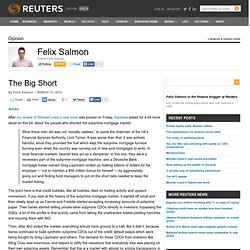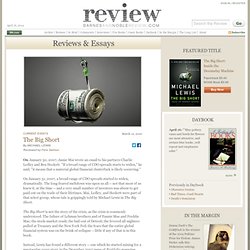

Goldman Sachs, génie du mal financier. - Le siège de Goldman Sachs au 85 Broad Street dans le quartier de la finance à Manhattan Brendan McDermid / Reuters - En 2008, le monde a découvert qu’une banque d’affaires, totalement inconnue du grand public, pouvait mettre en péril l’économie mondiale.

C’était Lehman Brothers, lâchée par la banque centrale américaine, et dont la faillite, le 14 septembre 2008, a déclenché la plus grande crise financière de l’histoire. Lehman Brothers anéantie, il reste une banque d’affaires dominante: celle que Marc Roche, correspondant du Monde à la City de Londres nomme LA Banque: Goldman Sachs. Une institution hyper puissante, présente dans tous les avatars de la crise. La crise grecque? Dans sa «biographie non autorisée», puisque les dirigeants de LA Banque n’ont voulu répondre à aucune de ses questions, Marc Roche souligne comment un modeste établissement en partenariat, longtemps spécialisé dans les financements aux entreprises, est devenu un monstre financier. Publicité Marie-Laure Cittanova. La Banque. Comment Goldman Sachs dirige le monde. Dans un film sur la finance, la banque Goldman Sachs tiendrait le rôle du méchant.

Normal, juge Marc Roche, elle a la gueule de l'emploi. Dans cette enquête menée au fil des ans entre New York, Bruxelles, Washington et surtout Londres, le correspondant du journal Le Monde à la City détaille chapitre après chapitre les turpitudes de la banque d'affaires américaine. On entre dans le monde étrange de ces "moines banquiers" qui peuvent aussi bien atteindre leur paradis, devenir l'un des 400 associés de la firme, porte ouverte sur la fortune et la gloire, que finir dans l'enfer de Noël, qui voit jusqu'à 10% du personnel, jugé non performant, mis à la porte chaque année.
Pour réussir chez Goldman, il faut abandonner toute autre forme de vie que son travail, avoir le goût du secret, de la performance et savoir travailler en équipe parce que les renseignements glanés par les uns font les futures commissions gagnées par les autres. Et les commissions, c'est le moteur de Goldman Sachs. La Banque. BrennerCrisisTodayOctober2009.pdf (Objet application/pdf) Analysis & Opinion. After my review of Michael Lewis’s new book was posted on Friday, Sandrew asked for a bit more detail on this bit, about the people who shorted the subprime mortgage market: What these men did was not “socially useless,” to quote the chairman of the UK’s Financial Services Authority, Lord Turner.

It was worse than that: it was actively harmful, since they provided the fuel which kept the subprime mortgage furnace burning even when the country was running out of new junk mortgages to write. In most financial markets, bearish bets act as a dampener; in this one, they were a necessary part of the subprime-mortgage machine, and a Deutsche Bank mortgage trader named Greg Lippmann ended up making billions of dollars for his employer — not to mention a $50 million bonus for himself — by aggressively going out and finding fund managers to put on the short bets needed to keep the market ticking. The Big Short. On January 30, 2007, Jamie Mai wrote an email to his partners Charlie Ledley and Ben Hockett.

"If a broad range of CDO spreads starts to widen," he said, "it means that a material global financial clusterfuck is likely occurring. " On January 31, 2007, a broad range of CDO spreads started to widen, dramatically. The long-feared meltdown was upon us all -- not that most of us knew it, at the time -- and a very small number of investors was about to get paid out on the trade of their lifetimes.
Mai, Ledley, and Hockett were part of that select group, whose tale is grippingly told by Michael Lewis in The Big Short. The Big Short is not the story of the crisis, as the crisis is commonly understood. Instead, Lewis has found a different story -- one which he started mining for a spectacular cover story in the December 2007 issue of Portfolio magazine, and which has culminated in this book, over two years later. On the face of it, there's almost nothing sympathetic about these men. The Greatest Trade Ever: The Behind-the-Scenes Story of How John.